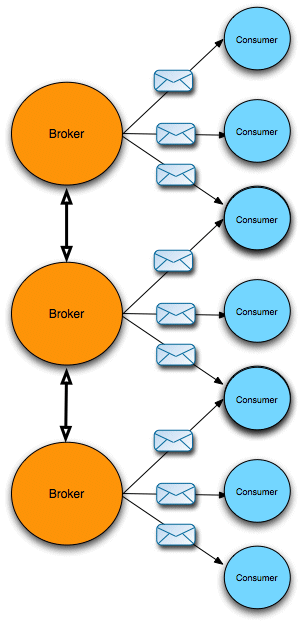Red Hat AMQ 6
As of February 2025, Red Hat is no longer supporting Red Hat AMQ 6. If you are using AMQ 6, please upgrade: Migrating to AMQ 7.Questo contenuto non è disponibile nella lingua selezionata.
2.7. Horizontal Scaling
Overview
Copia collegamentoCollegamento copiato negli appunti!
Horizontal scaling refers to the strategy of increasing capacity by adding multiple brokers to your messaging network. Figure 2.2, “Scaling with Multiple Brokers” illustrates how a broker network can be used to support a large number of consumers.
Figure 2.2. Scaling with Multiple Brokers
Broker networks
Copia collegamentoCollegamento copiato negli appunti!
You can improve the scalability of your messaging system by adding multiple brokers to the system, thus escaping the inherent resource limits of a broker deployed on a single machine. Brokers can be combined into a network by adding network connectors between the brokers, which enables you to define broker networks with an arbitrary topology.
When brokers are linked together as a network, routes from producers to consumers are created dynamically, as clients connect to and disconnect from the network. That is, with the appropriate topology, a consumer can connect to any broker in the network and the network automatically routes messages from producers attached at any other point in the network.
For a detailed discussion of how to set up broker networks, see "Using Networks of Brokers".
Static scales better than dynamic
Copia collegamentoCollegamento copiato negli appunti!
Red Hat JBoss A-MQ offers two alternative strategies for routing messages through a broker network: static propagation and dynamic propagation.
Although dynamic propagation is more flexible, it necessitates sending advisory messages throughout the broker network, which the brokers then use to figure out the optimal route in a dynamic way. As you scale up the network, there is a danger that the advisory messages could swamp the traffic in the broker network.
Static propagation requires you to specify routes explicitly, by telling the broker where to forward messages for specific queues and topics (you can use pattern matching). In this case, you can configure the brokers to disable advisory messages altogether, which eliminates the scalability problems associated with advisory messages.
Asynchronous network connection establishment
Copia collegamentoCollegamento copiato negli appunti!
By default, a broker establishes connections to its peers in the network using a single thread. If the broker connects to a large number of peers, however, the single-threaded approach can result in a very slow broker start-up time. For example, if one or more of the peers responds slowly, the initiating broker has to wait until that slow connection is established before proceeding to establish the remaining connections.
In this case, you can accelerate the broker start-up by enabling asynchronous network connection establishment. This feature employs a thread pool to establish network connections in parallel. Set the
networkConnectorStartAsync attribute on the broker element to true, as follows:
<beans ...> <broker ... networkConnectorStartAsync="true">...</broker> </beans>
<beans ...>
<broker ... networkConnectorStartAsync="true">...</broker>
</beans>Client-side traffic partitioning
Copia collegamentoCollegamento copiato negli appunti!
An alternative horizontal scaling strategy is to deploy multiple brokers, but to leave them isolated from one another, so that there is no broker network. In this case, you can leave it up to the clients to decide which broker to send messages to or receive messages from. This requires messages to be partitioned into different categories (for example, based on the destination name), so that specific message categories are sent to a particular broker.
The advantages of this approach are:
- You can use all the tuning techniques for vertical scaling.
- You can achieve better horizontal scalability than a network of brokers (because there is less broker crosstalk).
The disadvantage of this approach is that your clients are slightly more complex, because they must implement the partitioning of messages into different categories and the selection of the appropriate broker.
